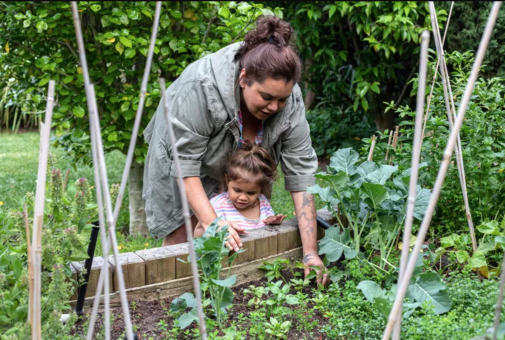Green America reports a surge of interest in people gardening for climate reasons.
If it seems like more people are gardening than ever before, you're not wrong. Green America is a non-profit that promotes the creation of Climate Victory Gardens. It tracks these in an interactive online map that just surpassed an impressive 8,000-garden milestone. As a point of reference, there were only 2,400 gardens on the map in April 2020, but that number has nearly quadrupled since, reaching 8,239.
What is a Climate Victory Garden? It's a garden that relies on regenerative methods, particularly those that minimize soil disturbance and improve the soil’s ability to hold carbon. The name acts as a reminder of just how important gardens can be in the fight against the climate crisis. It comes from the Victory Gardens that were planted across the United States during World Wars I and II. By the late 1940s nearly two million gardens produced 40% of produce consumed in the US.
Read more: Grow Food, Not Grass, to Fight Climate Change
Now we are fighting a war of a different kind. Gardens can reduce greenhouse gas emissions by shortening the number of miles food has to travel from farm to table. If done properly, they can improve soil health, reduce erosion, and sequester carbon. Backyard gardens can produce food without harmful chemical inputs and boost food security, ensuring that families have something to eat when store shelves are temporarily bare. As Green America explains on its website,
"When we grow food at home in a regenerative manner, we purchase less food that has traveled across the country, we keep methane-producing organic materials out of landfills with composting, we increase the water holding capacity of our soil to decrease flooding and runoff, and most importantly we rebuild our soil health bringing back its carbon sequestering potential."
Green America encourages everyone to start gardens and to upload their locations to the map. It has five criteria for gardens to be considered Climate Victory Gardens. These include: (1) Growing food, (2) covering soils, (3) composting and using it to nourish soil, (4) ditching chemicals, and (5) encouraging biodiversity.
There is no minimum size requirement for gardens to be included on the map. Todd Larsen, executive co-director for Consumer & Corporate Engagement at Green America, told Treehugger that the organization encourages people to start wherever they can.
"If they are living in an apartment we provide them with instructions for container gardening, and help them do it cheaply, utilizing materials on-hand. If they have a backyard, we help them start small (e.g. with a raised bed) and then expand from there. We want everyone to be able to take part, gain a love for gardening."
Larsen described some of the different types of gardens on the map. "[They] range from herb gardens up to gardens that are several acres, and include private gardens in people’s backyards, as well as community gardens. People have planted Climate Victory Gardens in right of ways, at schools – really all over the place."
While food does need to be grown for the garden to be considered a Climate Victory Garden (flowers alone don't count), Green America doesn't care how much is produced. "Some people are growing produce that is hard to get or expensive at the store in a relatively small plot. Others are growing most of the produce their family needs in a larger plot," Larsen explained. "If people want to grow enough produce in their garden to feed themselves year-round, they would need to allocate at least 200 square feet per person." Not everyone has access to that kind of space, nor the time and skill required to maintain it.
Green America isn't concerned about those details; it just wants people to get their hands dirty, to become familiar with the miraculous process that is growing food, and to understand the connection between doing so and fighting for the climate. You can learn more about Climate Victory Gardens by watching the short video below or visiting Green America's website that has plenty of resources for getting started. (So does Treehugger's Gardening category, so be sure to check that out.)





